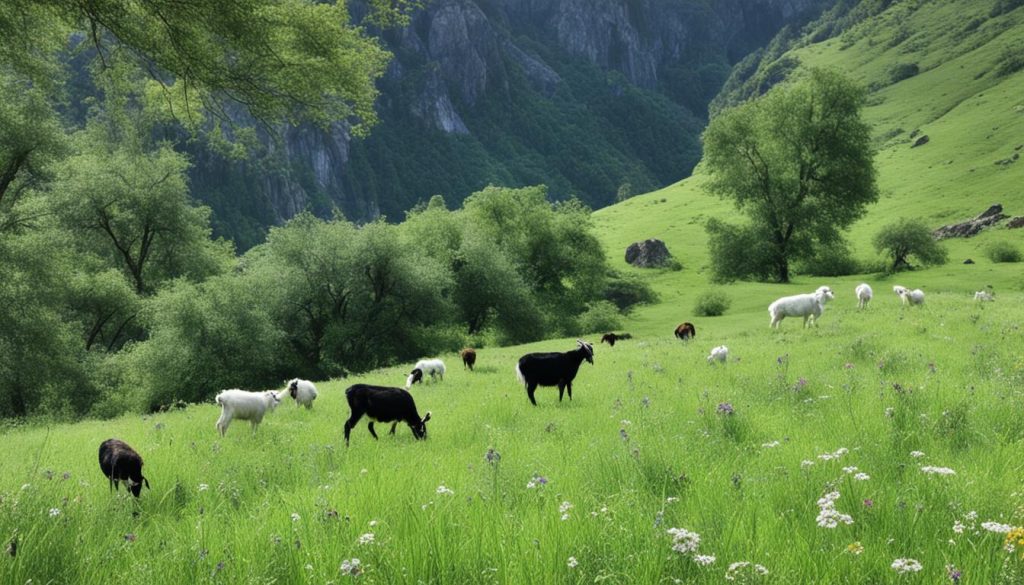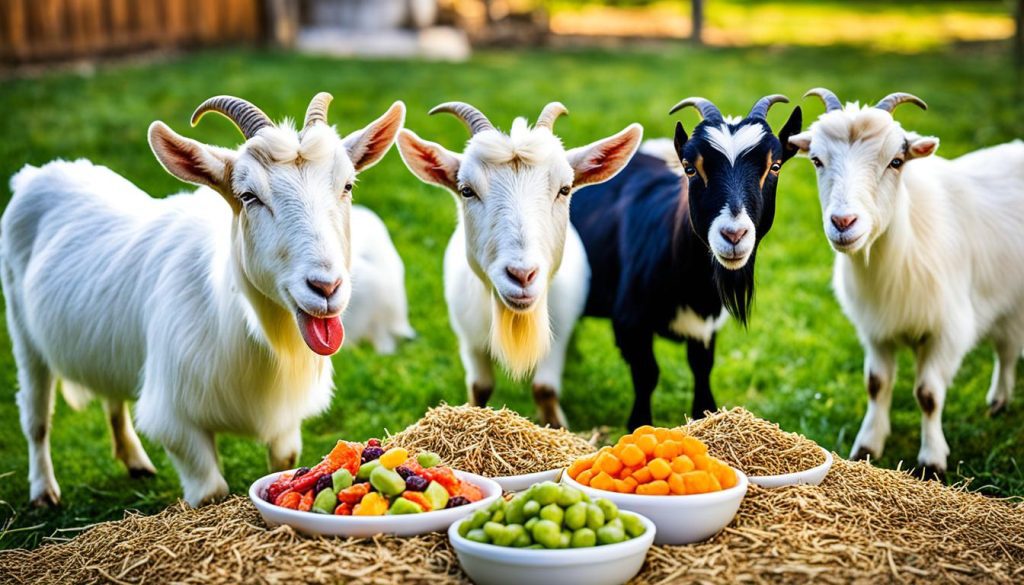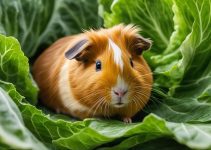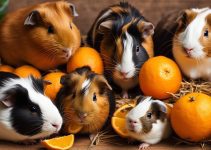I’m here to answer the burning question, “What do goats eat?” Contrary to popular belief, goats can’t just eat anything—they have a specific diet that keeps them healthy and thriving. As a copywriting journalist, I’ve done my research to provide you with all the information you need to understand a goat’s diet. So, let’s dive in!
Goats have a complex digestive system that requires a variety of foods to function properly. The main part of a goat’s diet is roughage, usually in the form of grass or hay. This roughage provides the necessary fiber for their digestive system and balances the moisture content in their rumen—a specialized compartment in their stomach. It’s important to feed goats high-quality hay that is free of mold or brown spots, as these can cause digestive and respiratory issues.
In addition to hay, goats need access to pasture. They are natural grazers and thrive on the nutrients found in different types of grass. However, it’s crucial to introduce lush pasture slowly to allow their system to adjust. Feeding grain is also necessary to ensure goats are getting enough nutrition, although they should not rely heavily on it. Treats can be given to goats occasionally, but the quantity should be limited to maintain a balanced diet.
To summarize, a healthy goat diet consists of grass hay, pasture, grain, and occasional treats. Providing the right balance of these foods is key to keeping goats happy and in good health. Now, let’s move on to the key takeaways from this section.
What Do Goats Eat?
- A goat’s diet primarily consists of roughage, such as grass or hay.
- High-quality hay is essential for providing the necessary fiber and moisture balance.
- Goats are natural grazers and require access to pasture to thrive.
- Feeding grain is necessary for proper nutrition, but it should not be the main source of food.
- Treats can be given occasionally, but their quantity should be limited.
Importance of Hay in a Goat’s Diet
Hay plays a critical role in a goat’s diet, providing essential nutrition and roughage for their overall health and well-being. As herbivores, goats require a diet that consists primarily of roughage, and hay fulfills this need perfectly.
When it comes to hay, grass hay is the most commonly used type for feeding goats. Varieties such as timothy hay, orchard grass, and fescue are nutritious options that provide the necessary fiber and nutrients for goats to thrive.
It’s important to differentiate hay from straw, as they serve different purposes. Hay is a valuable source of nutrition, while straw is mainly used for bedding due to its lack of nutritional value.
When selecting hay for your goats, it’s crucial to avoid brown hay. Brown hay indicates poor drying conditions or improper storage, which can result in low nutritional value and potential health issues for the goats.
Grass hay may consist of a blend of different grasses, each offering unique nutritional benefits. This variety ensures that goats receive a well-rounded and balanced diet. Additionally, alfalfa, a legume-based fodder with high protein content, can serve as a supplemental or alternative feed to grain.
Introducing alfalfa or any other high-protein feed should be carefully portioned according to the goat’s size and individual nutritional needs.
Hay is a crucial component of a goat’s diet, providing both nutrition and roughage. Grass hay, such as timothy hay, orchard grass, and fescue, ensures goats receive the necessary fiber and nutrients for optimal health. Differentiating hay from straw and avoiding brown hay are vital considerations when selecting the most suitable feed for goats. Supplementing with alfalfa can provide additional protein if needed.
The Role of Pasture in a Goat’s Diet
Pasture plays a vital role in a goat’s diet as they are natural grazers. In the wild, goats spend their days moving around and nibbling on various plants, including grasses, tree branches, and weeds. This grazing behavior is essential for their overall health and well-being.
When introducing goats to lush pasture, it is crucial to do so gradually. This is because the sudden change to fresh, wet green pasture can cause digestive upset in goats. By allowing them time to adjust, we ensure their systems can adapt to the new feed without any issues.
In addition to pasture, it is important to provide goats with plenty of hay. This helps balance their diet and ensures a consistent supply of nutrition and roughage. By offering hay alongside pasture feeding, we create a well-rounded and healthy diet for our goats.
Pasture rotation is also beneficial for goats. This practice involves moving goats to different grazing areas periodically. Rotational grazing helps keep the plant cycle healthy, leading to better forage availability and improved plant regeneration. Additionally, it helps minimize the risk of worm infestations by preventing the concentration of parasites in a single area.
Overall, incorporating pasture into a goat’s diet is crucial for their overall well-being. It allows them to exhibit their natural grazing habits, provides essential nutrients, and contributes to a balanced and healthy diet.

The Significance of Grain in a Goat’s Diet
While goats are natural grazers and not meant to eat much grain, feeding grain is necessary to ensure goats are receiving enough nutrition. Grain provides essential nutrients that may be lacking in their diet and helps maintain overall health and well-being.
Most grain formulas designed for goats provide around 16% protein, which is crucial for their growth and development. The amount of grain to feed should be determined based on the weight and nutritional needs of each goat.
When it comes to choosing the type of grain, sweet feed coated in molasses is particularly palatable to goats. This makes it an ideal option for training purposes or for administering supplements. The sweetness of the molasses can entice goats, making it easier to introduce new flavors and textures.
When incorporating grains into a goat’s diet, it’s important to do so gradually. Sudden changes in their diet can disrupt the balance of bacteria in their rumen, leading to digestive issues. By slowly increasing the amount of grain over time, goats have a chance to adjust to the new food without causing any discomfort.
While grain is beneficial for goats, it’s essential to prevent overconsumption. Excessive grain intake, especially sweet feed, can lead to urinary calculi, a condition where mineral deposits form in the urinary tract. Therefore, it’s crucial to monitor and limit the amount of grain given to goats, ensuring they receive a balanced diet.
Incorporating grain into a goat’s diet plays a significant role in meeting their nutritional requirements. Sweet feed, with its appealing taste, can be used as a training tool or for administering supplements. However, it’s important to introduce grain slowly and monitor the amount given to prevent any health complications. By providing the right balance of grain and other dietary components, goats can thrive and remain healthy.
Treats for Goats
Treats can be a delightful way to spoil your goats occasionally, but they should not make up a large part of their diet. When it comes to goat treats, it’s important to choose safe options that are suitable for their digestive system. Introducing treats gradually allows the goats’ digestive system to adapt and reduces the risk of digestive upset.
Some safe treats for goats include pumpkin and raspberry plants. Goats enjoy the taste of pumpkins and raspberries, and these treats provide them with essential nutrients. Pumpkin is rich in vitamins and minerals, while raspberry plants offer antioxidants that promote overall health.
It’s also worth considering kitchen scraps or garden produce as treats for your goats. While these can be a great way to make use of leftover food, it’s crucial to consult with a veterinarian before offering these treats. They can provide guidance on what types of scraps or produce are safe for goats and what should be avoided.
Treats should always be given in moderation to maintain a balanced diet and prevent weight gain. Remember, goats thrive on a diet that consists primarily of roughage such as grass hay, pasture, and grain. Treats should be seen as a special indulgence rather than a substantial part of their daily intake.

Introducing treats gradually not only prevents digestive upset but also helps goats maintain a healthy diet. By being mindful of the type and quantity of treats given, you can ensure your goats stay happy and healthy while enjoying the occasional indulgence.
Minerals and Vitamins in a Goat’s Diet
As a goat owner, I understand the importance of providing my goats with a balanced diet that includes all the necessary minerals and vitamins. These nutrients are essential for maintaining their health and ensuring the proper functioning of their physiological systems.
One of the crucial minerals in a goat’s diet is salt. Salt blocks can be provided to goats, allowing them to consume the necessary amount of salt they need. Salt is vital for maintaining proper hydration and supporting various bodily functions.
In addition to salt, goats require both microminerals and macrominerals to meet their nutritional needs. Microminerals, such as iron, copper, and selenium, play a vital role in various physiological processes, including enzyme function and immune system support. These minerals are typically present in small quantities in a goat’s diet and must be supplemented to ensure adequate levels.
- Iron: Essential for oxygen transportation within the body.
- Copper: Important for the formation of red blood cells and connective tissues.
- Selenium: Necessary for antioxidant protection and proper thyroid function.
On the other hand, macrominerals are required in larger quantities. Calcium, phosphorus, and magnesium are essential macrominerals that goats need for healthy bone development, muscle function, and overall growth. Ensuring the proper balance of these macrominerals is crucial for goats to thrive.
- Calcium: Essential for bone structure and milk production in lactating does.
- Phosphorus: Important for energy metabolism and proper skeletal development.
- Magnesium: Necessary for nerve and muscle function.
Aside from minerals, goats also require a sufficient intake of vitamins in their diet. Since goats are unable to synthesize fat-soluble vitamins, these must be provided through their feed or supplements.
Fat-soluble vitamins include:
- Vitamin A: Crucial for vision health, immune function, and growth.
- Vitamin D: Necessary for calcium absorption and bone health.
- Vitamin E: An antioxidant that helps protect cells from damage.
- Vitamin K: Important for blood clotting and bone health.
Feeding a balanced ration that meets the specific mineral and vitamin requirements of goats is key to ensuring their overall well-being. By providing the necessary minerals, vitamins, and fatty acids, goat owners can support their goats’ health and help them thrive.
Importance of Rotational Grazing for Goats
Rotational grazing is a beneficial practice for goats that offers several advantages, including better forage utilization and plant regeneration. This grazing management system involves dividing pastures into smaller paddocks and rotating goats between them, allowing each paddock to rest and recover while the goats graze in another area.
One important aspect of rotational grazing is stocking density, which refers to the number of goats per pasture. The appropriate stocking density may vary depending on the size of the pasture and the specific grazing system in place. It is essential to ensure that the number of goats grazing in each paddock is appropriate to maintain the health of the pasture and promote optimal forage utilization.
Grazing duration and frequency can also be adjusted in a rotational grazing system to further enhance the benefits. By carefully managing the time goats spend in each paddock, grazing pressure can be controlled, allowing plants to recover and regrow effectively. This approach promotes healthier plant growth and ensures a sustainable grazing cycle.
Rotational grazing is particularly valuable in two specific scenarios. In extensively managed schemes in arid environments, it helps prevent overgrazing and maintains pasture quality in regions where water resources are limited. Additionally, smaller goat operations in humid areas can also benefit from rotational grazing as it allows for more effective utilization of available forage, reducing the need for additional feed supplements.
Conclusion
A balanced and appropriate diet is crucial for the health and well-being of goats. Their diet should consist of a combination of grass hay, pasture, grain, and occasional treats. Hay provides essential nutrition and roughage, while pasture allows goats to practice their natural grazing habits.
Feeding grain to goats ensures they receive adequate nutrition, but it is important to give it in moderation. Treats can be given occasionally as a special indulgence, but they should not make up a large part of their diet.
Providing the necessary minerals, vitamins, and fats in a goat’s diet is essential. Goats require specific nutrients to maintain their overall health and proper physiological functioning. Furthermore, implementing rotational grazing practices is beneficial as it allows for better forage utilization and plant regeneration.
By following these guidelines and providing a well-rounded diet, goats can thrive and remain healthy. It is important to consider the specific needs of individual goats and consult with a veterinarian for further guidance on their dietary requirements.






